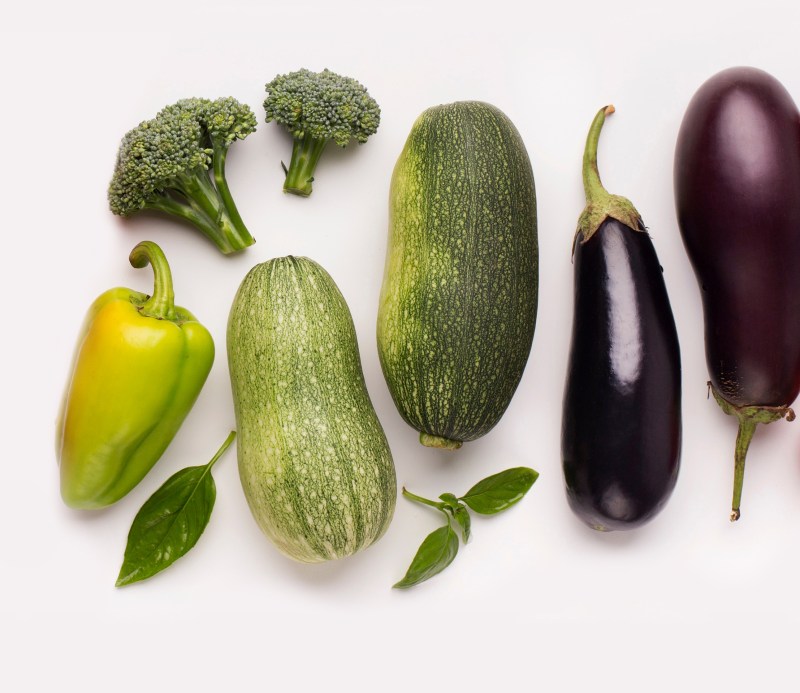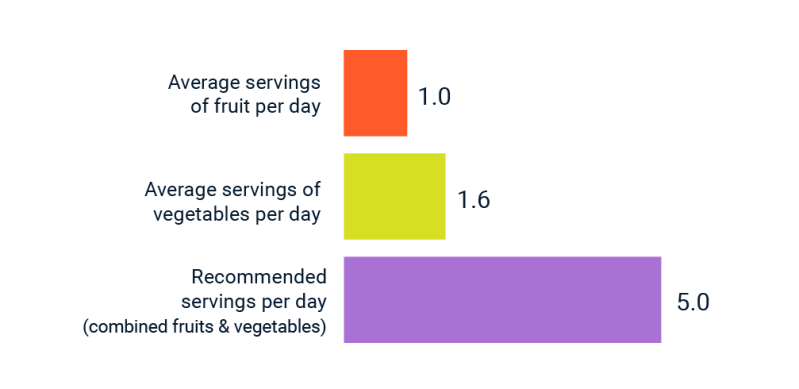WHITE PAPER

Produce First
A Compelling Case for Simplicity


Produce First
A Compelling Case for Simplicity

Supporting employee well-being is a priority for high-performing organizations, but finding effective ways to deliver clear, lasting results is a challenge. Most people already know that a nutritious diet rich in vegetables and fruits is vital to good health. Then why do so few of us eat well?
Typical workplace nutrition programs offer complex data, heavy tracking requirements, and strategies that can hinder lasting success even for those eager to make healthy changes. Scientific evidence suggests the most successful approach is also the simplest — by emphasizing produce first.
Good nutrition fuels a healthier brain and body, equipping employees to feel their best and show up ready to do great work. This paper focuses on an uncomplicated, produce-based approach that boosts effectiveness and delivers impressive benefits — including:
- Better mental health
- Improved well-being and vitality
- Increased ability to stick with positive changes
- Lower risk for costly chronic diseases.
Why Don’t We Eat Enough Produce?
Public campaigns and wellness programs routinely tout the benefits of more fruits and vegetables, but research reveals awareness rarely translates into action. Despite the widely publicized health benefits of a diet rich in colorful produce, Americans are actually eating less. Numbers like these underscore the need for a different approach:
- Socioeconomic barriers to adequate produce consumption are a reality for many families. In 2022, 12.8% (17 million) of US households experienced food insecurity.1
- The 2020 State of the Plate report found our frequency of eating produce dropped by almost 10% in 2004-2020. Most Americans eat produce, but only once a day, if that.2
- Healthy People 2030 data reveals little to no improvement from 2017-2020 in the amount of fruits and vegetables American adults and children consumed.3
- No US state yet satisfies the Centers for Disease Control’s modest national objectives for fruit (75% of people eating 2+ servings/day) or vegetables (50% of people eating at least 3 servings/day). Only 1 in 10 US adults meets recommendations.4
The sheer volume of dietary information and program options is overwhelming. It’s easier for workers to tune out healthy eating strategies than to sort through countless, often contradictory choices. Employers promoting healthy eating need compelling messages to cut through the noise and inspire results.
Unscrambling all the data with a clear point like produce first is a crucial link that helps transform knowledge into action.
Current Median Daily Intake of Fruits and Vegetables in the US

Why Don’t We Eat Enough Produce?
The 2020 State of the Plate Report asked respondents to rank barriers to eating produce as well as motivating factors. Results inform practical strategies that support a higher level of fruit and vegetable consumption.
Top barriers included:
- Needing new menu ideas
- Budget constraints
- Planning healthful meals
- Accessing meals quickly.
Top motivators included:
- Quick/easy to make
- Nutritious choice
- Items on hand
- Favorite food.
The common theme from this survey is convenience matters. When choosing produce is easy and affordable — and meal prep is quick and simple — people are more likely to eat fruits and vegetables. Offer convenient options like these – with discounts or subsidies, if possible:
- Weekly Consumer-Supported Agriculture (CSA) produce delivery for onsite and remote workers
- Weekly or biweekly onsite farmers’ market
- Produce-rich meals in the cafeteria plus grab and go to take home
- Fruit and vegetable vending options
- Produce snacks at meetings and conferences
- Easy produce-based recipes and sample meal plans.
Will Your Messages Lead to Action?
Highlight simple, practical, how-to tips like these in your participant communications to spark action:
- Choose produce first. Snack on an apple or veggies and hummus; make produce the centerpiece of your meal, adding small amounts of lean protein as garnish.
- Save money and reduce food waste by cooking with frozen or canned (unsalted or drained and rinsed, unsweetened) fruit and vegetables.
- Select prechopped, prewashed salad or stir-fry mixes, baby carrots, snap peas, and cherry tomatoes for faster snacks and meal prep.
- Buy veggies on sale in bulk; chop and freeze for convenient future use.
- Cook with dried or canned beans (like pinto, black, garbanzo) and lentils to add protein, fiber, and flavor to meals while saving money.
What About Protein?
Wellness leaders may encounter participants concerned about getting enough protein when the emphasis is on more fruits and vegetables. The truth is that a balanced, plant-rich diet doesn’t sacrifice protein:
- All plants contain protein, some more than others. Beans and lentils, green peas, kale, Brussels sprouts, and spinach are protein-rich vegetable examples. Guava, avocado, jackfruit, kiwi, and blackberries are among the fruits that are good sources.
- The protein package matters. Plant sources come with a wide assortment of health-promoting antioxidants, phytonutrients, and fiber, which animal sources don’t provide.
- Many people overdo it on protein. It’s not necessary — or healthful — to take in too much. This macronutrient should make up 10%-35% of daily calories, depending on health factors and activity level (athletes and other active people need more).
- A balanced diet contains protein from a variety of sources in addition to fruits and vegetables: nuts, seeds, and whole grains; plant- products (tofu, tempeh, soy milk); eggs, dairy products; fish, lean meats, and poultry.
- Eating the right amount of protein-rich choices leaves room in the diet for other foods vital to well-being.
Why Eat More Produce?
Multiple studies confirm that eating more vegetables and fruits is associated with a long list of health-enhancing, risk-reducing benefits:
- Mental health. Any increase in daily produce is linked to improved well-being as well as happiness plus reduced depression and stress. The strongest effect is seen with 6-8 servings/day.5
- Enhanced brain function. Eating more produce improves cerebral blood flow and is related to better brain function as well as a lower risk of cognitive impairment.6
- Decreased inflammation. Diets high in fruits and vegetables enhance immune function while reducing inflammation, helping prevent elevated risk for many chronic conditions like heart disease, dementia, type 2 diabetes, arthritis, and autoimmune disorders.7
- Healthier hearts. People who eat 5+ servings/day of produce have a nearly 15% lower risk of heart attack and 20% lower risk of heart disease than those who consume much less.8,9 Each extra helping decreases heart disease rates by 4%, especially the robust antioxidants in green leafy vegetables and vitamin C-rich items. Vegetarians typically have higher levels of salicylic acid — a chemical that acts like aspirin to ease pain and reduce harmful heart inflammation — than nonvegetarians.10
- Curtailed ultraprocessed (UP) foods. Between 2002-2018, the amount of UP foods eaten by US adults grew to 57% of daily calories, while minimally processed foods (such as fresh and frozen produce) dropped to 27%.11 Eating more vegetables and fruits would reverse this trend and help crowd out UP foods, which increase risk of overweight/obesity, metabolic syndrome, depression, cancers, and other conditions.12
- Lower blood pressure. In a large clinical trial, those who ate more vegetables and fruits decreased systolic blood pressure by 2.8 mm Hg and diastolic blood pressure by 1.1 mm Hg.13
- Reduced stroke risk. People getting 5+ daily servings of produce are 30% less likely to suffer a stroke than those eating <3 servings. Each additional serving further lowers stroke risk by 6%.14
- Decreased diabetes risk. A meta-analysis of 23 studies linked high vs. low combined fruit and vegetable intake to a 7% reduction in risk of type 2 diabetes.15
- Avoidance of metabolic syndrome. Individuals who consume the most fruit are 34% less likely to develop metabolic syndrome; those who ate the most vegetables are 30% less likely.16
- Cancer prevention. Evidence points to a protective effect of produce against many types of cancer.17
- Healthier body weight. A produce-rich diet can mean a 24% lower risk of obesity and a 28% lower risk of gaining weight over time.18 Those who eat the most fruit have the least body fat.19
- Stronger bones. Choosing fruits and vegetables, especially packed with vitamin C, results in higher bone mineral density.20,21
- Eyesight protection. Better nutrition and more vitamin C result in clearer eye lenses.22 Women who eat more produce have a 10%-15% reduced risk of developing cataracts.23
According to the World Health Organization, over 2.6 million lives could be saved each year only by eating enough vegetables and fruits.24 But living longer isn’t the only benefit. Enhanced mental and physical well-being that stems from habitually eating nutrient-rich foods helps people feel their best — an important springboard for performing well on the job and living a happy, fulfilling life.
Produce first is a strong approach to help people make lasting nutrition changes that improve well-being, performance, and quality of life.
Why Not Apply Simplicity as the Key?
How Can You Simplify Workplace Nutrition Programs for Success?
Simplicity — the essential ingredient for long-term nutrition improvement — can:
- Promote healthy eating habits
- Improve participation with easy-to-remember, easy-to-follow guidelines
- Decrease confusion caused by information overload
- Streamline program planning
- Inspire long-term well-being
- Maximize compliance with dietary guidelines
- Reduce average healthcare costs/participant.
More ideas to promote success:
- Make convenience count. Keep grab-and-go snacks like apples, oranges, and bananas easily accessible in cafeterias and vending areas. Label produce-rich choices healthy or sustainable for enhanced appeal.26
- Concentrate on the spectrum of produce. Inspire employees to focus on color, variety, and freshness instead of counting calories or weighing portions.27 Brighter, deeper hues not only look and taste better, they also indicate higher concentrations of vitamins, antioxidants, and minerals.
- Underscore education. Provide workers with plentiful practical tips (such as knowing what makes up a serving and putting produce at the top of the grocery list) as well as easy vegetable/fruit recipes.
- Spread the word. Post produce first messages throughout work spaces — break rooms, cafeterias, online — to inspire consistent healthy choices.
- Create a positive atmosphere and help make wellness-promoting nutrition habits permanent with support from coworkers and team leaders.
- Remember happiness matters. Accentuate the emotional and psychological benefits of this simplified nutrition approach. The enhanced sense of well-being and satisfaction from healthier eating matters as much as with physical activity.
- Call for action. Emphasize that physical activity in conjunction with a healthy, produce-based diet yields the best results. Good nutrition and an active lifestyle go hand in hand.
- Unify your approach. Reach out to all levels of staff and leadership to be part of produce first to enhance unity and create a positive culture for change.
What Are the Benefits?
Removing the complexity from workplace healthcare and wellness initiatives contributes to a happier, healthier workforce plus bottom-line benefits. Employees who participate in these programs are absent less often and feel more job satisfaction.28
A simple nutrition message such as produce first may also offer long-term financial payoffs by lowering average healthcare costs/participant:
- Researchers examining a simple employer-sponsored, internet-based nutrition program noted an average healthcare cost reduction of $827 for participants with cardiovascular risks.29
- In a 2023 Tufts University report, researchers underscore the impact of systematically improving access to fruits and vegetables. Their scientific model predicts that a national healthcare-based produce prescription program for people with diabetes and food insecurity would save billions in hospitalizations, improve quality of life, and lengthen lives.30
- A study of Virginia’s simple nutrition program concluded that each $1 spent yielded $10.64 in healthcare savings, either by delaying disease onset or preventing it altogether.31
Employers who invest in workplace wellness reap near-term benefits as well as future savings — and help transform employees’ lives with healthier lifestyles.
Conclusions
- Although the consumer healthcare market is saturated with nutrition information and wellness strategies, already low levels of US produce consumption continue to decline. Wellness leaders need powerful messages to reverse these trends. Studies show that people learn, retain, and act on simple guidelines like produce first more successfully than nutrition plans with complex rules.
- Plentiful evidence-based research supports the effectiveness of high produce levels in enhancing well-being as well as delaying or preventing chronic and life-threatening disease.
- Employers who implement and enthusiastically support workplace nutrition initiatives like produce first see near-term gains — happier, healthier employees and increased retention — in addition to future reductions in healthcare costs.

Eating well can be as simple as making Colorful Choices. By choosing a daily rainbow — red, orange, yellow/white, green, and blue/violet — of fabulous fruits and vivid vegetables, healthy nutrition can be enjoyable, filling, and fun.
Watch the 1-minute preview video at colorfulchoices.com.
2 Produce for Better Health Foundation, State of the Plate Executive Summary 2020, https://fruitsandveggies.org/wp-content/uploads/2021/04/2020-PBH-State-Of-The-Plate-Executive-Summary-1.pdf
3 Healthy People 2030, Nutrition and Healthy Eating, Overview and Objectives, retrieved Dec. 5, 2023
4 Lee SH, Moore LV, Park S, Harris DM, Blanck HM. Adults Meeting Fruit and Vegetable Intake Recommendations — United States, 2019, Morbidity and Mortality Weekly Report, 2022;71:1–9. DOI: http://dx.doi.org/10.15585/mmwr.mm7101a1
5 Głąbska D, Guzek D, Groele B, Gutkowska K. Fruit and Vegetable Intake and Mental Health in Adults: A Systematic Review. Nutrients, 2020 Jan 1;12(1):115. DOI: 10.3390/nu12010115. PMID: 31906271; PMCID: PMC7019743
6 Carrillo JÁ, Zafrilla MP, Marhuenda J. Cognitive Function and Consumption of Fruit and Vegetable Polyphenols in a Young Population: Is There a Relationship? Foods, 2019 Oct 17;8(10):507. DOI: 10.3390/foods8100507. PMID: 31627296; PMCID: PMC6836211
7 Hosseini B, Berthon BS, Saedisomeolia A, Starkey MR, Collison A, Wark PAB, Wood LG. Effects of Fruit and Vegetable Consumption on Inflammatory Biomarkers and Immune Cell populations: A Systematic Literature Review and Meta-Analysis. American Journal of Clinical Nutrition, 2018 Jul 1;108(1):136-155. DOI: 10.1093/ajcn/nqy082. PMID: 29931038
8 Law MR, Morris JK. By How Much Does Fruit and Vegetable Consumption Reduce the Risk of Ischaemic Heart Disease? European Journal of Clinical Nutrition, 1998;52(8):549-556
9 Joshipura KJ, Hu FB, Manson JE, Stampfer MJ, Rimm EB, Speizer FE, Colditz G, Asherio A, Rosner B, Spiegelman D, Willett WC. The Effect of Fruit and Vegetable Intake on Risk for Coronary Heart Disease. Annals of Internal Medicine, 2001;134(12):1106-1114
10 Blacklock CJ, Lawrence JR, Wiles D, Malcolm EA, Gibson IH, Kelly CJ, Paterson JR. Salicylic Acid in the Serum of Subjects Not Taking Aspirin. Comparison of Salicylic Acid Concentrations in the Serum of Vegetarians, Non-Vegetarians, and Patients Taking Low Dose Aspirin. Journal of Clinical Pathology, 2001;54(7):553-555
11 Juul F, Parekh N, Martinez-Steele E, Monteiro CA, Chang VW. Ultra-Processed Food Consumption Among US Adults From 2001 to 2018. American Journal of Clinical Nutrition, 2022 Jan 11;115(1):211-221. DOI: 10.1093/ajcn/nqab305. PMID: 34647997
12 Lane MM, Davis JA, Beattie S, et al. Ultraprocessed Food and Chronic Noncommunicable Diseases: A Systematic Review and Meta-Analysis of 43 Observational Studies. Obesity Reviews, 2021; 22:e13146. DOI: 10.1111/obr.13146
13 Appel LJ, Moore TJ, Obarzanek E, Vollmer WM, Svetkey LP, Sacks FM, Bray GA, Vogt TM, Cutler JA, Windhauser MM, Lin P, Karanja N. A Clinical Trial of the Effects of Dietary Patterns on Blood Pressure. The New England Journal of Medicine, 1997;336(16):1117-1124
14 Joshipura KJ, Ascherio A, Manson JE, Stampfer MJ, Rimm EB, Speizer FE, Hennekens CH, Spiegelman D, Willett WC. Fruit and Vegetable Intake in Relation to Risk of Ischemic Stroke. Journal of the American Medical Association, 1999;282(13):1233-1239
15 Halvorsen RE, Elvestad M, Molin M, Aune D. Fruit and Vegetable Consumption and the Risk of Type 2 Diabetes: a Systematic Review and Dose-Response Meta-Analysis of Prospective Studies. BMJ Nutrition, Prevention & Health, 2021 Jul 2;4(2):519-531. DOI: 10.1136/bmjnph-2020-000218. PMID: 35028521; PMCID: PMC8718861
16 Esmaillzadeh A, Kimiagar M, Mehrabi Y, Azadbakht L, Hu FB, Willett WC. Fruit and Vegetable Intakes, C-Reactive Protein, and the Metabolic Syndrome. American Journal of Clinical Nutrition, 2006;84(6):1489-1497
17 World Cancer Research Fund/American Institute for Cancer Research. Diet, Nutrition, Physical Activity and Cancer: a Global Perspective. Continuous Update Project Expert Report 2018, https://wcrf.org/diet-activity-and-cancer/
18 He K, Hu FB, Colditz GA, Manson JE, Willett WC, Liu S. Changes in Intake of Fruits and Vegetables in Relation to Risk of Obesity and Weight Gain Among Middle-Aged Women. International Journal of Obesity and Related Metabolic Disorders, 2004;28(12):1569-1574
19 Davis JN, Hodges VA, Gillham MB. Normal-Weight Adults Consume More Fiber and Fruit Than Their Age-and Height-Matched Overweight/Obese Counterparts. Journal of the American Dietetic Association, 2006;106(6):833-840
20 Prynne CJ, Mishra GD, O’Connell MA, Muniz G, Laskey MA, Yan L, Prentice A, Ginty F. Fruit and Vegetable Intakes and Bone Mineral Status: A Cross-Sectional Study in 5 Age and Sex Cohorts. American Journal of Clinical Nutrition, 2006;83(6):1420-1428
21 New SA, Robins SP, Campbell MK, Martin JC, Garton MJ, Bolton-Smith C, Grubb DA, Lee SJ, Reid DM. Dietary Influences on Bone Mass and Bone Metabolism: Further Evidence of a Positive Link Between Fruit and Vegetable Consumption and Bone Health? American Journal of Clinical Nutrition, 2000;71(1):142-151
22 Jacques PF, Chylack LT, Hankinson SE, Khu PM, Rogers G, Friend J,Tung W, Wolfe JK, Padhye N, Willett WC, Taylor A. Long-Term Nutrient Intake and Early Age-Related Nuclear Lens Opacities. Archives of Ophthalmology, 2001;119(7):1009-1019
23 Christen WG, Liu S, Schaumberg DA, Buring JE. Fruit and Vegetable Intake and the Risk of Cataract in Women. American Journal of Clinical Nutrition, 2005;81(6):1417-1422
24 Lock K, Pomerleau J, Causer L, Altmann DR, McKee M. The Global Burden of Disease Attributable to Low Consumption of Fruit and Vegetables: Implications for the Global Strategy on Diet. Bulletin of the World Health Organization, 2005;83(2):100-108
25 Feldman J. The Simplicity Principle in Human Concept Learning. Current Directions in Psychological Science, 2003:12(6):227-232, https://journals.sagepub.com/doi/full/10.1046/j.0963-7214.2003.01267.x
26 Sleboda P, Bruine de Bruin W, Gutsche T, Arvai J. Don’t Say “Vegan” or “Plant-Based”: Food Without Meat and Dairy Is More Likely to Be Chosen When Labeled as “Healthy” and “Sustainable.” Journal of Environmental Psychology, 2024, Volume 93, 102217, ISSN 0272-4944, DOI: 10.1016/j.jenvp.2023.102217
27 Robinson L, Segal R. Healthy Eating. March 2023, https://www.helpguide.org/articles/healthy-eating/healthy-eating.htm
28 Parks KM, Steelman LA. Organizational Wellness Programs: A Meta-Analysis. Journal of Occupational Health Psychology, 2008;13(1):58-68
29Sacks N, Cabral H, Kazis LE, Jarrett KM, Vetter D, Richmond R, Moore TJ. A Web-Based Nutrition Program Reduces Health Care Costs in Employees With Cardiac Risk Factors: Before and After Cost Analysis. Journal of Medical Internet Research, 2009; 11(4):e43
30Tufts University, Report Shows Food Is Medicine Interventions Would Save Lives and Billions of Dollars, Tufts Now, Sept 26, 2023, https://now.tufts.edu/2023/09/26/report-shows-food-medicine-interventions-would-save-lives-and-billions-dollars
31 Rajgopal R, Cox RH, Lambur M, Lewis EC. Cost-Benefit Analysis Indicates the Positive Economic Benefits of the Expanded Food and Nutrition Education Program Related to Chronic Disease Prevention. Journal of Nutrition Education and Behavior, 2002; 34(1):26-37
